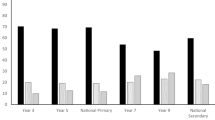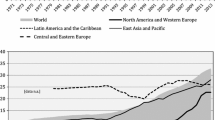Abstract
Performance indicators and performance-based funding are becoming integral components of higher education (HE) policy around the globe. We explore some of the implications of this type of policy on Norwegian HE. We believe the case will be of significant interest to policy-makers, stakeholders and academics alike, not least because our empirical analysis indicates that competition for students is relatively stable and not particularly aggressive across groups of higher education institutions (HEIs) and over time. Despite this fact, a few HEIs have improved their share of applications, while others have fallen behind in the competition for students. The paper is based on a unique data set drawn from the Norwegian Universities and Colleges Admission Service during the period 2003–2009.
Similar content being viewed by others
References
Aamodt, P. O. (1995). Floods, bottlenecks and backwaters: An analysis of expansion in higher education in Norway. Higher Education, 30(1), 63–80.
Aamodt, P. O., Hovdhaugen, E., & Opheim, V. (2009). Effects of a national higher education reform on the academic progress of students. Journal of Adult and Continuing Education, 15(2), 220–234.
Aamodt, P. O., & Kyvik, S. (2005). Access to higher education in the Nordic countries. In T. Tapper & D. Palfreyman (Eds.), Understanding mass higher education: Comparative perspectives on access (pp. 121–138). London: RoutledgeFalmer.
Becher, T., & Trowler, P. (2001). Academic tribes and territories: Intellectual enquiry and the culture of the disciplines (2nd ed.). London: Routledge.
Becker, G. S. (1975). Human capital: A theoretical and empirical analysis, with special reference to education. New York, NY: Columbia University Press.
Boudon, R. (1974). Education, opportunity and social inequality. New York, NY: John Wiley.
Bourdieu, P., & Passeron, J.-C. (1977). Reproduction in education, society and culture. London: Sage.
Chapman, R. (1984). Towards a theory of college choice: A model for college search and choice behaviour. Edmonton: University of Alberta Press.
Clark, B. R. (1983). The higher education system: Academic organization in cross-national perspective. Berkeley, CA: University of California Press.
Frolich, N. (2008). The politics of steering by numbers: Debating performance-based funding in Europe. NIFU STEP Report No. 3/2008. Oslo: NIFU STEP.
Freiich, N. (forthcoming). Multi-layered accountability: Performance funding of universities. Public Administration.
Frelich, N., Brandt, S., Hovdhaugen, E., & Aamodt, P. O. (2009). Coping by copying? Higher education institutions’ student recruitment strategies. Tertiary Education and Management, 75(3), 227–240.
Frelich, N., Schmidt, E. K., & Rosa, M. J. (2010). Funding systems for higher education and their impacts on institutional strategies and academia: A comparative perspective. International Journal of Education Management, 24(1), 7–21.
Frelich, N., & Stensaker, B. (2010). Student recruitment strategies in higher education. Promoting excellence and diversity? International Journal of Education Management, 24(4), 359–370.
Frelich, N., & Strom, B. (2008). Higher education and incentives: Evidence from a Norwegian funding reform. European Journal of Education, 43(4), 563–576.
Goldthorpe, J. H. (2000). On sociology. Numbers, narratives and the integration of research and theory. Oxford: Oxford University Press.
Hossler, D., & Gallagher, K. (1987). Studying college choice: A three-phase model and the implication for policy makers. College and University, 62(3), 207–221.
Hovdhaugen, E., Frelich, N., & Aamodt, P. O. (forthcoming). Informing institutional management: Institutional strategies and student retention. European Journal of Education.
Kyvik, S. (2009). The dynamics of change in higher education: Expansion and contraction in an organisational field. Dordrecht: Springer.
Larsen, I. M. (2007). Om styling og ledelse av universiteter og hogskoler. Mellom fagfellesskap, hierarki, politikk og marked [On the management and governance of higher education institutions. Between disciplines, hierarchy, politics and the market]. Oslo: Unipub AS.
Liefner, I. (2003). Funding, resource allocation, and performance in higher education systems. Higher Education, 46(4), 469–489.
March, J. G., & Olsen, J. P. (1996). Institutional perspectives on political institutions. Governance, 9(3), 247–264.
OECD (Organisation for Economic Co-operation and Development). (2008). Tertiary education for the knowledge society (Vol. 1). Paris: Author.
Pollitt, C., & Bouckaert, G. (2000). Public management reform: A comparative analysis. New York, NY: Oxford University Press.
Taylor, J., & Taylor, R. (2003). Performance indicators in academia: An X-efficiency approach? Australian Journal of Public Administration, 62(2), 71–82.
Williams, G. (1992). Changing patterns of finance in higher education. Bury St Edmunds: St Edmundsbury Press.
Author information
Authors and Affiliations
Corresponding author
Rights and permissions
About this article
Cite this article
Frølich, N., Waagene, E. & Aamodt, P.O. Old Players—New Rules: Higher education institutions’ response to educational demand. Tert Educ Manag 17, 163–179 (2011). https://doi.org/10.1080/13583883.2011.552628
Received:
Accepted:
Published:
Issue Date:
DOI: https://doi.org/10.1080/13583883.2011.552628




